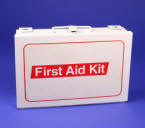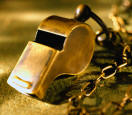|

www.RichardPresents.com
|
Let's Go Camping ! |
|
Safety Tips and practical advice on how to pack that
vital first aid kit when out camping.
First thing first, take lessons
There are a lot of classes available that provide first
aid lessons. There is a basic EMT or emergency medical
technician course that one could take. However, for
those who do not have much time, short lessons are
available. The American Red Cross provides such courses.
Check your local community. Basic first aid lessons are
generally inexpensive yet valuable once learned.
Children could also be given basic first aid
information. When camping with children, be sure they
are familiar with your first aid
kit. Show them the items inside the first aid kit
and when and how to use them.
A child who
knows or has a basic idea of first aid will panic less
if an injury or a slight emergency situation occurs.
First aid kit: what to pack and
how

To better understand your first aid kit, get a manual. The American Red Cross provides a
good one.
Also, a small Swiss Army knife is a very useful tool to
take along.
Take along an emergency blanket. Be aware that a blanket made of wool
could get wet and develop a slight odor. You can get emergency blankets that don't weigh much and
can easily be packed.
A razor blade can also be included -
great for removing splinters.
Pack a
magnifying glass. Use it for close-up
examination of plant and insect life - maybe even to
start a fire if you run out of matches. Be sure to use
waterproof matches.
Mirrors are useful especially when signaling for help.
Of course, it would be better if you do not need to have
a reason to use it other than for vanity.
|
Family Camping
Tips

 Current
Camping News Reports Current
Camping News Reports
|
A thermometer is another item that could be
taken on a camping trip. It'll be a big help
in deciding how to dress when you get up in
the morning.
A cold pack can be used to prevent any exhaustion that is
caused by heat. It could also be used to
treat burns, sprains, bruises,
swelling, toothaches and headaches.
A water packet – the sterilized kind – usually
containing about four ounces of water is an
efficient and useful item used for drinking
ot cleaning a wound. Water packets have a
long shelf life - sometimes as long as five years.
For wounds, a medical tape should also be
includeed.
Also, try to pack in threads and a needle.
Gloves, safety pin, scissors, eye dressing,
band aid as well as a wrap bandage that is
elastic.
For any injuries, pack a triangular bandage and
gauze pads.
A roll of gauze, along with antiseptic
wipes, a lip balm (to
protect the lips from the sun), and
Neosporin (for kids with small wounds)
For adults, a pain reliever like Tylenol
should also be available. For children, a
non-aspirin tablet should be available.
A Decongestant like Dimetapp is a good
medicine to bring. Antihistamines are a
great option for adults. For a hot camping
trip, don't forget to pack salt tablets.
Keep in touch even when camping out
Set boundaries and follow them
Camping, especially if there are kids around, could be
quite a complicated activity. To make it
less complex and safe, try to set some
boundaries in and around the campsite.
Advise campers, especially kid campers, what
things they should do and not do
with or without an adult; supervision. An
effective method is requiring kids to always
be with a buddy. This could be an assigned
partner where one could check in on each
other on where the other’s location is, or
update the rest of the group of any location
changes.
Familiarize everyone with the surroundings
Upon arriving in the camp, make sure that you
and your campers immediately become familiar with the surroundings. Try to take
note of any noticeable landmarks.
A large tree perhaps, yet make sure
these landmarks are locatable in relation
to the campsite.

Whistle, whistle, whistle - Give each camper,
especially children campers, their very
own whistle. Establish a code for specific
situations that everyone could easily follow
and heed. For example, a whistle blown two
times could be established to mean “help.”
Whistles that are blown three times could
mean “I am here.”
Color your world
- Or at least, have campers carry trash
bags that are colored brightly. Once lost,
these bags could be used as a device to
signal to the others your location. Also,
the bags could be used during an emergency
like when it's cold outside and someone need
temporary shelter. Simply cut a slit at the
bag’s top and slide it over their
heads. Believe it or not, this plastic bag
could serve as an effective albeit temporary
protection that could keep a kid camper
alive through the night.
Choose a camp that provides high-tech communication.
There are camp sites that provide campers
the same amenities one would usually find in
civilization. Email facilities, fax as well
as phone equipments are available.
This type of camp is perfect for those who might want
to be in touch with their business or
personal affairs while at the camping
grounds. This type of camp strikes a balance
between the rugged outdoors and the comfort
and convenience of modern technology.
Make use of high-tech communication tools -
Cell phones and hand held (walkie-talkie)
radios.
Laser Range finders are now just as handy as
radios. Though they were once large and
difficult to actually use, today’s finders
are light, user-friendly and extremely
accurate.
Global positioning system. Personal, easy to
carry units are available.
Night vision goggles. The movies are not the
only place this equipment could be seen and
used. These devices are now readily
available, very easy to use, light weight,
compact and handy.
All in all, staying in touch while camping out may be a
bit difficult if you have no idea how to go
about it. To be able to avoid this, prepare
beforehand the equipment and rules for your
family camping experience.
Camping should be
fun. Ample preparation adds to the enjoyment,
lessens the stress, and assures the safest
and most fun filled family camping
experience.
|
Remember
Your Basic A,
B,
C's
A
is for ALWAYS tell somebody where you're
going and when you'll be back. Before you
hit the trail, check in at the ranger
station or park office. That way, if they
see a strange car parked in the lot after
closing, they will send out a search party.
B
is for BE prepared. This is more than the
Boy Scout motto; it is the recipe for
survival. That means know where you're going
- i.e., look at a map - and have some idea
about what to expect when you get there.
C
is for CARRY a survival kit. It doesn't
matter if you are going for a day hike along
the Hillsborough River or flying to a field
station in the middle of Venezuelan
rainforest, pack some emergency gear in case
things get ugly.
|
RESOURCES:
|
|
RichardPresents.com
SHARING THE GOOD STUFF ON LINE
Old School Bldg, Rm D1
230 Centre Street
Langhorne, PA 19047 USA
TO TOP |
|
|